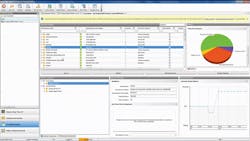Wong: Why don’t you tell us a bit about your background in the electronics industry and what brought you to Ciiva?
Gawne: Growing up in a family of engineers, I tinkered with electronics from a young age and went on to study electronic engineering at the University of Manchester. The decade prior to founding Ciiva, I was involved in the automotive and embedded spaces in a mix of system, software, and hardware development roles, experiencing many of the problems firsthand that we are trying to help solve today.
As one of the original founders of Ciiva, I’m responsible for making sure that our customers are successful in realizing their designs. This means ensuring we develop the right solutions to our customers’ problems, and that our customers can use the solutions effectively in order to reach their ultimate goal of product realization, which is the process of taking an electronic design to a physical PCB assembly.
Wong: What would you say is the biggest problem people have with product realization?
Gawne: One of the biggest product-realization challenges is getting to a manufacturable bill of materials (BOM) and keeping that BOM manufacturable throughout the life of the product. The BOM that is formed from an electronic computer-aided design (ECAD) process will often be sufficient enough to represent the design intent, but not to actually enable the product to be produced.
Iterative cycles to resolve part number issues and unavailable components take time, and a lack of preventative maintenance on the BOM means that problems often arise at the last-minute that could have been dealt with much earlier on in the design process. Effectively controlling BOM and treating it as a first-class citizen is central to continuous realization, which is why Ciiva was developed in the first place: to help people overcome these common BOM-management challenges.
Wong: What makes Ciiva different from other electronics realization tools?
Gawne: Most BOM tools focus on the mechanical computer-aided-design (MCAD) domain. Ciiva focuses specifically on the ECAD domain, which has fundamental differences to MCAD. ECAD is lightweight and focuses on enabling users to manage their BOM data in an agile way without the process overhead of more traditional solutions typically tailored to bigger enterprises.
We support individuals and small teams that are often comprised of multi-discipline engineers. We also place a strong focus on tightly integrating BOM control and part analysis into a single tool, making it very easy for customers to control the BOM structure and content while at the same time decorating their information with a wealth of other technical, lifecycle, and supply-chain data.
Wong: How does an ECAD BOM differ from an MCAD BOM?
Gawne: An ECAD BOM comprises commercial-off-the-shelf (COTS) electronic components; often the only custom part in the BOM is the PCB. An MCAD BOM is the polar opposite, consisting of custom fabricated mechanical parts. Multi-source capabilities in ECAD enable drop-in replacement components to be used so that designers can easily swap out components from different manufacturers, and the supply chain consists of a variety of distribution channels and vendors.
While obsolescence is an issue in the MCAD domain with material availability, it is arguably a more complex problem to manage in the electronics domain due to the number of different components used in a design, and the fact that many parts require very specialized manufacturing capabilities. These inherent differences mean tools that are good at managing MCAD BOMs are often not as effective for ECAD BOMs.
Ciiva's BOM Manager
Wong: Other companies like Silicon Expert and IHS provide similar BOM management services. Aside from using an ECAD focus, what else makes Ciiva unique?
Gawne: These solutions tend to be expensive and out of reach for many designers who we are interested in supporting. Other solutions slot into the process at a point and require conscious actions to extract value from them. Ciiva is attempting to integrate at the point where the BOM is created, when that first component is placed into the design. At this point, Ciiva already knows about the BOM—this passive approach means that engineers don’t actually have to do anything before Ciiva can start working for them. As we continue to develop our products, we’re focused on bringing value to our customers without them having to consciously remember to do anything, and we will be interwoven into the fabric of the development process.
At the end of the day, we’re simply engineers building products for other engineers. We’re leveraging our own very real experiences and learning from our customers to approach problems pragmatically and offer truly different alternatives to the usual ways of doing things, and I believe that this is ultimately what sets Ciiva apart from similar tools. While many solutions are a piece in the puzzle—slotting in at a specific point in the process, which can create an impedance mismatch in the whole process—we’re trying to do the opposite. Our goal is to bring continuity between design, manufacture, and supply by being embedded from the beginning to the end of the toolchain.
Wong: Earlier, you said Ciiva was a lightweight tool. Could you explain what you mean by that and why it’s important?
Gawne: Engineers are creative people who take great pride in product design and development. The last thing we want to do is introduce additional overhead to an already complicated process that dilutes the value we’re trying to bring.
It is very important that we make Ciiva as unobtrusive and as easy to use as possible—it must be perceived as something that’s an engineer’s friend, a guardian in the realization domain and not another tedious step in the process. We’re focusing our efforts on developing products for the masses, the individuals and small teams, which have for a long time been neglected in this space as other solutions can be too heavy and/or expensive.
Wong: Are there any other design-to-manufacturing workflow improvements offered by Ciiva?
Gawne: Your BOM exists from the moment you select that first component in your design to the point where that design is retired and the product is no longer produced. However, the BOM is treated as a design output that’s often the cause of problems and is left to rot in an Excel spreadsheet.
Ciiva ensures that the BOM can live a full and fruitful life, and in doing so connects the design, manufacturing, and supply-chain domains in a way that is simply not possible for many people today. Free flow of information across these domains helps to reduce repeat mistakes and error propagation. This makes the workflow a much more seamless, complete, and enjoyable experience for engineers, procurement personnel, and contract manufacturers alike.
Wong: What’s the next five years for Ciiva?
Gawne: We will continue to build our capabilities around being able to understand and leverage data in ways that have not been seen before in the electronics domain, bringing the design, manufacturing, and supply domains closer together. Ensuring that the right data is available at the right time, and that it is used in the right way, will help us bring new checks and balances and automate existing processes in a way that drive not a just a “right first time,” but a “right all the time” philosophy. Many pieces to the realization puzzle need to be put in place to be really effective in delivering truly time-saving, effective, and easy-to-use solutions for our customers, and it will take time and effort to get this right.
Wong: Is there anything else about Ciiva that you’d like people to know about?
Gawne: We have been very busy behind the scenes building a foundation on which our realization platform will continue to be built, with a rollout later this summer. New and existing products will leverage this foundation to ensure that we have an extensible, accessible base for moving forward.


